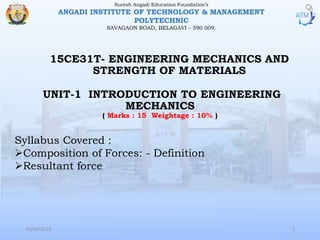Composition of forces
•Download as PPTX, PDF•
0 likes•429 views
Law of Parallelogram of forces
Report
Share
Report
Share

Recommended
Recommended
Force: Defined as an agent which produces or tends to produce, destroys or tends to destroy motion.Composition & Resolution of Forces | Engineering Mechanics

Composition & Resolution of Forces | Engineering MechanicsInternational Institute of Information Technology (I²IT)
More Related Content
What's hot
Force: Defined as an agent which produces or tends to produce, destroys or tends to destroy motion.Composition & Resolution of Forces | Engineering Mechanics

Composition & Resolution of Forces | Engineering MechanicsInternational Institute of Information Technology (I²IT)
What's hot (20)
moments couples and force couple systems by ahmad khan

moments couples and force couple systems by ahmad khan
Composition & Resolution of Forces | Engineering Mechanics

Composition & Resolution of Forces | Engineering Mechanics
Unit 1 orthographic projection engineering graphics

Unit 1 orthographic projection engineering graphics
Similar to Composition of forces
Similar to Composition of forces (20)
Theoretical Mechanics | Forces and Other Vector Quantities |

Theoretical Mechanics | Forces and Other Vector Quantities |
Engineering mechanics-question-and-answers-for-gate-ias

Engineering mechanics-question-and-answers-for-gate-ias
Recently uploaded
From customer value engagements to hands-on production support, our Services span across every stage of our customers digital transformation journey, to help ensure that every customer is successful in their adoption of our solutions.
• Implementation, Upgrade, Migration, and Maintenance Services
• On-Premises and On-Cloud
• COTS Training Services; On-Site and Virtual
• Software Support Services; Legacy and 3DEXPERIENCE
• Value Engagement & Blueprinting
• Specialized Consulting and Support Services
• Customized Training Services
• Automation and Configuration Services
• Technical Resource Augmentation Services
• Project Management
• Know-how Training (mentoring) and Resource AugmentationNavigating Complexity: The Role of Trusted Partners and VIAS3D in Dassault Sy...

Navigating Complexity: The Role of Trusted Partners and VIAS3D in Dassault Sy...Arindam Chakraborty, Ph.D., P.E. (CA, TX)
Recently uploaded (20)
S1S2 B.Arch MGU - HOA1&2 Module 3 -Temple Architecture of Kerala.pptx

S1S2 B.Arch MGU - HOA1&2 Module 3 -Temple Architecture of Kerala.pptx
scipt v1.pptxcxxxxxxxxxxxxxxxxxxxxxxxxxxxxxxxxxxxxxxxxxxxxxxxxxxxxxxxxxxxxxxx...

scipt v1.pptxcxxxxxxxxxxxxxxxxxxxxxxxxxxxxxxxxxxxxxxxxxxxxxxxxxxxxxxxxxxxxxxx...
XXXXXXXXXXXXXXXXXXXXXXXXXXXXXXXXXXXXXXXXXXXXXXXXXXXX

XXXXXXXXXXXXXXXXXXXXXXXXXXXXXXXXXXXXXXXXXXXXXXXXXXXX
Navigating Complexity: The Role of Trusted Partners and VIAS3D in Dassault Sy...

Navigating Complexity: The Role of Trusted Partners and VIAS3D in Dassault Sy...
Hazard Identification (HAZID) vs. Hazard and Operability (HAZOP): A Comparati...

Hazard Identification (HAZID) vs. Hazard and Operability (HAZOP): A Comparati...
Composition of forces
- 1. 15CE31T- ENGINEERING MECHANICS AND STRENGTH OF MATERIALS Suresh Angadi Education Foundation’s ANGADI INSTITUTE OF TECHNOLOGY & MANAGEMENT POLYTECHNIC SAVAGAON ROAD, BELAGAVI – 590 009. 10/10/2019 1 Syllabus Covered : Composition of Forces: - Definition Resultant force UNIT-1 INTRODUCTION TO ENGINEERING MECHANICS ( Marks : 15 Weightage : 10% )
- 2. 10/10/2019 2 Resultant of Forces There are usually several different forces acting on an object. The overall motion of the object will depend on the size and direction of all the forces. The motion of the object will depend on the resultant force. This is calculated by adding all the forces together, taking their direction into account.
- 3. 10/10/2019 3 3 The process of replacing a force system by its resultant is called composition. The Resultant of a pair of concurrent (occurring at the same time and gathering at the same point) forces can be determined by means of Parallelogram Law, which states that: Two forces on a body can be replaced by a single force called the resultant by drawing the diagonal of the parallelogram with sides equivalent to the two forces. Composition of Forces Stevinus (1548-1620) was the first to demonstrate that forces could be combined by representing them by arrows to some suitable scale, and then forming a parallelogram in which the diagonal represents the sum of the two forces. In fact, all vectors must combine in this manner. For example if F1 and F2 are two forces, the resultant ( R ) can be found by constructing the parallelogram.
- 4. 10/10/2019 4 Law of Parallelogram of Forces “If two forces, acting at a point be represented in magnitude and direction by the two adjacent sides of a parallelogram, then their resultant is represented in magnitude and direction by the diagonal of the parallelogram passing through that point.” Let two forces P and Q act at a point O as shown in Fig. 1 The force P is represented in magnitude and direction by OA whereas the force Q is presented in magnitude and direction by OB. Let the angle between the two forces be ‘a’. The resultant of these two forces will be obtained in magnitude and direction by the diagonal (passing through O) of the parallelogram of which OA and OB are two adjacent sides. Hence draw the parallelogram with OA and OB as adjacent sides as shown in Fig. 2. The resultant R is represented by OC in magnitude and direction
- 5. Magnitude of Resultant (R) From C draw CD perpendicular to OA produced. Let α = Angle between two forces P and Q = ∠AOB Now ∠DAC = ∠AOB (Corresponding angles)= α In parallelogram OACB, AC is parallel and equal to OB. • ∴ AC = Q. In triangle ACD, AD = AC cos α = Q cos α CD = AC sin α = Q sin α. In triangle OCD, • OC2 = OD2 + DC2. 10/10/2019 5 But OC = R, OD = OA + AD = P + Q cos α And DC = Q sin α. ∴ R2 = (P + Q cos α)2 + (Q sin α)2 = P2 + Q2 cos2 α + 2PQ cos α + Q2 sin2 α = P2 + Q2 (cos2 α + sin2 α) + 2PQ cos α = P2 + Q2 + 2PQ cos α (∵ cos2 α + sin2 α = 1) ∴ R = P2+ Q2+ 2PQcos α
- 6. • Direction of Resultant Let θ = Angle made by resultant with OA. Then from triangle OCD, 10/10/2019 6
